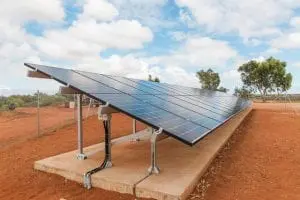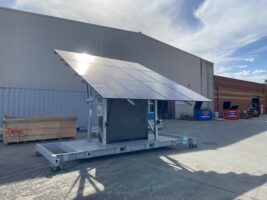Imagine the year is 2030.
You are walking down your street. Your local newsletter just announced that your community is now running on 100% renewable energy. You are thinking about that as you walk – even though energy is largely invisible in our lives, you can sense the changes.
Your street looks different. Seven years ago in 2023, only a few of your neighbours had solar panels. You look up now and you can see solar panels on your roof, on next door’s, on the house across the road – in fact on almost every single roof.
Your street also sounds different. There’s Fred in his new electric ute. Isn’t it quiet? Three of your neighbours in quick succession whizz past on electric bikes, and you wave to each of them. The teen from next door passes you on her electric scooter and you encourage her to slow down.
Your street smells different too. That whiff of exhaust you used to get when a car passed you? – that’s a thing of the past. Buses and trucks? They also don’t smell anymore.
But did I say 2030? That’s only seven years away. Could we really get to 100% renewable energy by then?
I believe we can,
I believe we must, and I believe that we need community energy.
I’ll give you three reasons why:
· We need to go fast
· We need to go in the right direction
· If we can’t afford it, it won’t happen
Let’s start with the speed of our energy transition – do you think we can transform our homes and transform our streets in a mere 7 years?
Here’s a picture of the transformation by the motor car. Photographs of the same street in New York, just 13 years apart.


13 short years and the car is a technology that transformed society.
That was a long time ago though.
The rise of smart-phones is probably a better example of a transformation that all of us have experienced. Can you remember when you first heard of a smart-phone? How long after that did you own one?
Changes can happen very fast and it can feel like we blink and the world has changed.
For nerds in the energy industry though, this moment of change is a long time coming.
30 years ago, as a young engineer, I made a solar cell, climbed a wind turbine and helped make Irish industries more energy efficient. In 2016, I travelled through America, Europe and Japan on a Churchill Fellowship.
I had 88 meetings about energy transitions, mostly with ordinary folk who were making the transition happen in their community. Almost every community had someone like me who had been chipping away at changes for a long time. Someone on my travels referred to us as the people with lousy timing.
I prefer to think of us as far-sighted. We were excited back then about what we could do to fix the energy system. Now, we might actually get to see it happen. We’ve been waiting 30 years. Some of us longer. We are ready to blink and see the world change.
And we all believe it will need community energy.
Who hasn’t recruited a tech-savvy friend or family member to help with their smart-phone?
Sometimes, it might be you doing the teaching – not because you’re technically more adept, but because you learnt this trick first, or you have a better understanding of what might work for your friend. Community energy can draw the early adopters of technology in to help the rest of us.
If you want to go fast, go alone. If you want to go far, go together.
I don’t think our governments, our energy market bodies and our energy corporates are getting the energy transition right. They are struggling to get the social approval they need for the big expensive decisions that they are making. They are trying to pave the way for billion dollar investments in transmission lines, offshore wind farms and hydrogen futures, and it is unsurprising that they face a growing chorus of resistance.
On my travels, I visited the scenes of resistance. Burlington in Vermont and Schoenau in Germany won their battles 20 years ago and are today, iconic renewable energy towns. Movements in California and Colorado were having mixed results in their battles but had won a range of concessions from the energy corporates and governments and they were persistent. They had pursued changes for over a decade.
In Hamburg, the community was appalled that a brand new coal-fired power station could be built in the 2000’s when it was obvious to your average citizen that we needed to transition away from coal-fired power.
As a result, this community voted to buy back their electricity system. The local government were supporters of the private owners, Vattenfall. A few years later with fierce advocacy and campaigning, that government was out of office. They’ve recently announced that the coal-fired power station will be converted to hydrogen.
If there is one lesson for the ‘powers that be’ from my Churchill Fellowship it is that communities will fight you if the direction you take is not a good direction. And oftentimes those communities will win.
So community energy is the answer to going fast, and to going in the right direction.
What about delivering on budget? Can we do that too?
Most of the communities I visited on my travels were not fighting, they were building. Building the clean energy future they wanted to see. As I said before, if you want to go far, go together. You might be surprised about who needs to be involved in helping make changes happen in a community. Energy has its tentacles in every part of society.
Samsø island in Denmark is a wonderful example of building 100% renewable energy system. They like to boast that they are at the centre of Denmark and Denmark is at the centre of the world. So Samsø is at the centre of the world!

In the north part of Samsø, they already had a district heating plant part-powered by solar hot water. They realised that they needed to transform housing to get an affordable district heating system in the South of the island so they asked everyone to improve the energy efficiency of their home by 25% before they would connect them.
They could then build the district heating plant 25% smaller. It is powered by waste straw which every farmer on the island is responsible for producing. Having enough straw to heat all winter was an extra incentive to make the design as efficient and cost-effective as possible.
The Samsø community also negotiated preferential lending from the local bank so that everyone could own part of the offshore wind turbines that create a substantial part of their renewable electricity supply. Two of the turbines are cooperatively owned by community investors. Five are owned by local government.
So you can see that energy has its tentacles in other systems, like building and planning codes and access to finance – especially for those who can’t afford to invest. Changing our energy system means changing those other systems too.
Let me introduce you to Martin. Martin is a marine engineer who runs many of the energy assets for a small Danish community called Hvide Sande. He runs the local cogeneration plant and district heating scheme, which includes the solar hot water system and two large hot water storage tanks.
The community agreed to three wind turbines on its beach because the income would allow them to upgrade the harbour. Martin takes the wind energy when they can’t get a good price on the market and stores it in his hot water tanks.
We don’t have the same history around shared local energy systems in Australia, but we may need to consider having a Martin in each of our communities. Maybe we will need to coordinate our hot water systems to chase surplus renewables without blowing the fuse on our local transformer.
Maybe a neighbourhood battery will make more sense than everyone owning one. For a start it would provide the whole street with a convenient fast charger for our cars. (Yes, that’s a confession from me – I forgot to plug the car in last night!).
And a Martin in each of our communities could help us manage our energy costs too. While most of us want to set and forget on energy, it helps to have one person around who is paid to make sure we are all getting the best deal.
By now you know my answer to our energy transition is community energy.
And I know I’ve made it look like a doddle but its not.
Our race to renewable energy risks causing as many problems as it is solving. It will be worth nothing if we end up with an energy system that is just as unsustainable as our current situation.
We can’t afford to overlook the impacts of the chemicals and materials we choose to use in our technologies.
And we can’t afford the wealthiest 20% of people on the planet to continue to co-opt 80% of the resources to prop up our wealth.
I have great faith that we can grapple with the trade-offs and advocate for the deep, long-term sustainability our planet needs as communities.
I have less faith that governments and energy corporates will do that unless they are pressured by us. They have a tendency to do enough and call it sustainability.
I want to leave you with one last story. Back in 1978 Denmark was at a crossroads. It had just suffered through a global oil shock and was determined to become more self-sufficient and secure for energy.
This was a point when many other countries, including neighbouring Sweden, committed to nuclear power stations. You might recognise the sticker because it went around the world in different languages – ‘Nuclear power – no thanks’. That sticker originated in Denmark.
The modern wind industry originated in Denmark too. The Tvind Turbine, which still stands today, was built by a small cohort of teachers and students to show their fellow Danes that a wind future was possible. 400 volunteers were involved and until the year 2000, this was the best performer among large turbines world wide.
It’s a remarkable story. And I hope it inspires you to join your local community energy group.
We are all around Australia, under many names that reflect our commitment to a better planet and a speedy energy transition. We have names like Zero Emissions, Community Energy or Totally Renewable. Others calls themselves Sustainable communities or Transition Towns. These are names that reference the climate emergency. More recently, they are names that reflect the great work of Saul Griffith and the Rewiring Australia movement like ‘Electrify 2515’ or ‘Electrify Canberra.’
Community energy is the answer.
A speedy, affordable and truly sustainable energy transition is the question.
And you can be part of it.
Join us!
Heather Smith is chair of the Coalition for Community Energy (C4CE).










